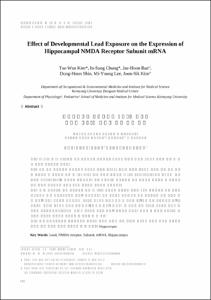KUMEL Repository
1. Journal Papers (연구논문)
1. School of Medicine (의과대학)
Dept. of Preventive Medicine (예방의학)
해마신경세포 발생단계별 NMDA 수용체 아단위 mRNA 발현에 대한 연의 영향
- Keimyung Author(s)
- Chung, In Sung; Shin, Dong Hoon; Lee, Mi Young; Bae, Jae Hoon; Kim, Joon Sik
- Department
- Dept. of Preventive Medicine (예방의학)
Dept. of Physiology (생리학)
Dept. of Pediatrics (소아청소년학)
Institute for Medical Science (의과학연구소)
- Journal Title
- 대한산업의학회지
- Issued Date
- 2005
- Volume
- 17
- Issue
- 4
- Abstract
- Objectives: The purpose of the present study was to examine the differential effects of lead (Pb) exposure on the expression of specific NMDA receptor subunit mRNAs on the hippocampal cells depending on the neuronal developmental stage.
Methods: Expression of the NR2A and NR2B subunits of the NMDA receptors mRNA on the hippocampal neurons was measured by in situ hybridization in the control and Pb treated groups. Pb-treated and NMDA cytotoxicity was assessed by morphological examination and LDH measurements .
Results: Hippocampal NR2A subunit mRNA expression was gradually increased with increasing age, and was significantly decreased after Pb exposure. The expression of NR2B subunit mRNA was not changed during development in the rat hippocampus and the developmental effect of Pb exposure on NR2B expression was minimal. These results indicate that chronic Pb exposure may decrease the levels of NR2A-containing NMDA receptors and may thereby alter normal synaptic signal transmission. Pb or NMDA-induced cytotoxicity in vitro differed significantly between the immature and the mature hippocampal cells.
Conclusions: This study demonstrates that chronic Pb exposure during brain development alters the levels of specific NMDA receptor subunit mRNA in the rat hippocampus. These results suggest that chronic Pb exposure may attenuate the precise neuronal synaptic transmission through the differential alteration of the composition of the NMDA receptor subunit on the hippocampus depending on neuronal developmental stage.
목적: in vivo 및 in vitro에서 해마 신경세포의 발생단계별 NMDA 수용체 아단위 mRNA 발현에 대한 연 폭로 영향을 알아보고자 하였다.
방법: 흰쥐 해마 신경세포의 발생단계별 NMDA 수용체 NR2A, NR2B 아단위 mRNA 발현에 대한 연의 영향은 정상군과 연 폭로군의 출생 후 7일, 14일, 22일 흰쥐의 해마에서 in situ hybridization으로 mRNA 발현정도를 densitometer 로 측정하여 비교하였고, 연과 NMDA의 세포독성은 해마 신경세포 일차배양 후 도립현미경을 이용한 형태학적인 관찰과 LDH 활성도를 이용하여 측정하였다.
결과: 연 과 NMDA에 의한 세포독성에 대한 in vitro 실험에서 형태학적 소견과 LDH 활성도에서 해마 미성숙신경세포와 성숙 신경세포사이의 차이가 있었으므로, 연과 NMDA 독성효과는 해마 신경세포의 발달 단계에 따라 차이가 있다. 정상군의 해마에서의 NR2A mRNA 발현은 출생 후 연령이 증가함에 따라 점진적으로 증가하였으나, NR2B mRNA 발현은 연령의 증가에 따른 변화가 없었다. 연 폭로에 희한 NR2A mRNA 발현은 유의하게 감소하였으나(p<0.05), NR2B mRNA 발현은 변화가 나타나지 않았다. 만성적 연 폭로는 NR2A를 포함하는 NMDA 수용체를 감소시킬 수 있음을 알 수 있다.
결론: 연은 해마신경세포의 발생단계에서 NMDA 수용체 아단위 특히 NR2A mRNA 발현의 변화를 야기하여 시냅스 신호 전달에 영향을 나타냄을 알 수 있었다.
- Alternative Title
- Effect of Developmental Lead Exposure on the Expression of Hippocampal NMDA Receptor Subunit mRNA
- Publisher
- School of Medicine
- Citation
- Tae-Wan Kim et al. (2005). 해마신경세포 발생단계별 NMDA 수용체 아단위 mRNA 발현에 대한 연의 영향. 대한산업의학회지, 17(4), 278–287.
- Type
- Article
- ISSN
- 1225-3618
- 파일 목록
-
-
Download
 oak-bbb-2079.pdf
기타 데이터 / 113.08 kB / Adobe PDF
oak-bbb-2079.pdf
기타 데이터 / 113.08 kB / Adobe PDF
-
Items in Repository are protected by copyright, with all rights reserved, unless otherwise indicated.